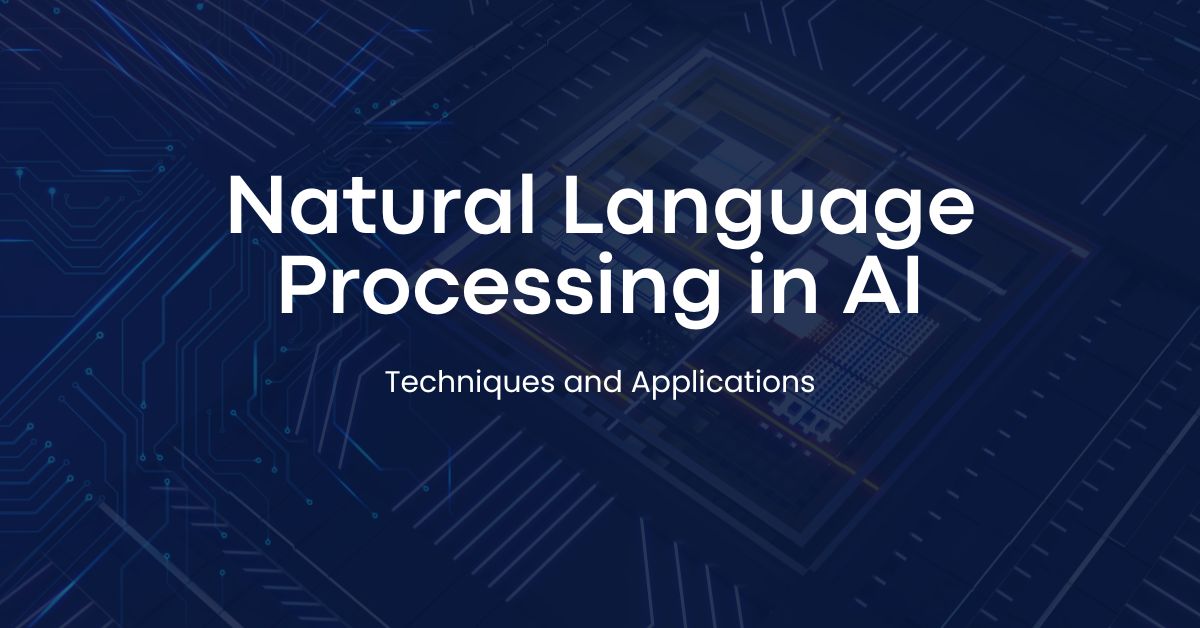Natural Language Processing (NLP) in AI: Techniques and Applications
Natural Language Processing (NLP) is like a translator that bridges the gap between two people who speak different languages. It is a groundbreaking field that bridges the gap between human language and machine understanding. It is the key that opens the door to a world where computers can understand not only the words we speak or write but also the intricate layers of meaning, intention, and sentiment behind them.
NLP has gained tremendous importance in recent years, enabling computers to comprehend, interpret, and generate human language. Hence, considering the importance of NLP in AI, in this blog, we will discuss the key techniques and applications of NLP, shedding light on the pivotal role it plays in various fields and its impact on our daily lives.
Understanding NLP
As the name suggests, Natural Language Processing (NLP) is the study of how computers can interact with humans through natural language. It encompasses a wide array of techniques and methods, all aimed at enabling machines to understand and generate human language. NLP is a multidisciplinary field that draws from linguistics, computer science, and machine learning.
Key Techniques in NLP
Below are the top techniques Natural Language Processing (NLP) uses to extract data from the text:
- Tokenization: Tokenization is the foundational step in NLP, breaking down text into smaller words or tokens for analysis. It allows computers to analyze and manipulate text at a granular level. Tokenization makes it easier for machines to understand the structure and meaning of a given text. Different tokenization methods are suitable for different contexts, such as rule-based for languages with clear structures and sub-word tokenization for handling morphological variations.
- Part-of-Speech Tagging: This technique entails labeling each word in a sentence with its parts of speech, such as nouns, verbs, adjectives, and adverbs. Part-of-speech tagging is essential for tasks like sentiment analysis, named entity recognition, and machine translation.
- Named Entity Recognition (NER): NER is used to identify and categorize entities in text, such as names of people, organizations, locations, dates, and more. This is crucial for applications like information extraction and text summarization.
- Sentiment Analysis: Sentiment analysis, alternatively known as opinion mining, involves determining the sentiment or emotion conveyed in a text, be it positive, negative, or neutral. This is widely used in customer feedback analysis, social media monitoring, public opinion, and brand reputation management.
- Stemming and Lemmatization: Stemming involves removing word affixes to obtain a base form, while lemmatization considers a word’s meaning and context, producing a valid base or root word.
- Machine Translation: Machine translation systems, like Google Translate, use NLP techniques to automatically translate text from one language to another. These systems rely on statistical models and neural networks to improve translation accuracy.
These are a few major techniques of NLP in AI. Understanding the nuances and trade-offs of each technique is crucial for effective NLP applications.
Applications of NLP
Natural Language Processing (NLP) has revolutionized the way we interact with technology, bringing forth a plethora of applications that enhance efficiency and understanding across various domains. Let’s delve into the diverse realms where NLP plays a pivotal role:
- Virtual Assistants: Virtual assistants like Siri, Alexa, and Google Assistant rely heavily on NLP to understand and respond to spoken or typed commands. They can perform tasks like setting reminders, answering questions, and controlling smart home devices.
- Chatbots: NLP-powered chatbots have become ubiquitous in customer service and online support, allowing them to respond contextually and even comprehend emotional sentiments for effective interactions. They can engage in natural-sounding conversations, helping users find information, make reservations, and solve problems.
- Search Engines: Search engines like Google use NLP to interpret search queries and provide relevant search results. NLP helps in understanding the intent behind the user’s query and delivering the most appropriate results.
- Social Media Analysis: Social media platforms employ NLP to analyze and categorize user-generated content, identify trends, and detect sentiments from unstructured social media data. This data is valuable for businesses and marketers to tailor their strategies.
- Healthcare: NLP is used in healthcare to extract information from medical records, assist in diagnosis, and manage patient data. It can also be applied to monitor and analyze health-related content on the internet.
- Content Summarization: NLP algorithms can produce summaries of long documents, simplifying the process for users to extract key information from lengthy articles or reports.
- Language Translation: Machine translation, powered by NLP, has made communication between people who speak different languages more accessible and efficient.
- Legal and Compliance: Legal professionals use NLP to review and analyze contracts, legal documents, and case histories, significantly reducing the time and effort required for document analysis.
Challenges and Future Developments
While NLP has made remarkable progress, it still faces challenges, including handling slang, understanding context, and addressing bias in language models. The field is continuously evolving, with ongoing research in neural network architectures, transfer learning, and fine-tuning techniques. The future of NLP holds exciting prospects, such as improved human-computer interaction, better language understanding, and applications in fields we can’t yet foresee.
Natural Language Processing is a transformative technology that has found its way into countless applications, making our lives more convenient and efficient. Its ability to bridge the gap between human language and machines is a testament to the remarkable advancements achieved in the field of Artificial Intelligence. As NLP continues to evolve, its potential for impact across industries and in our everyday lives is limitless, and it’s safe to say that the future will be shaped by the way we communicate with machines.
